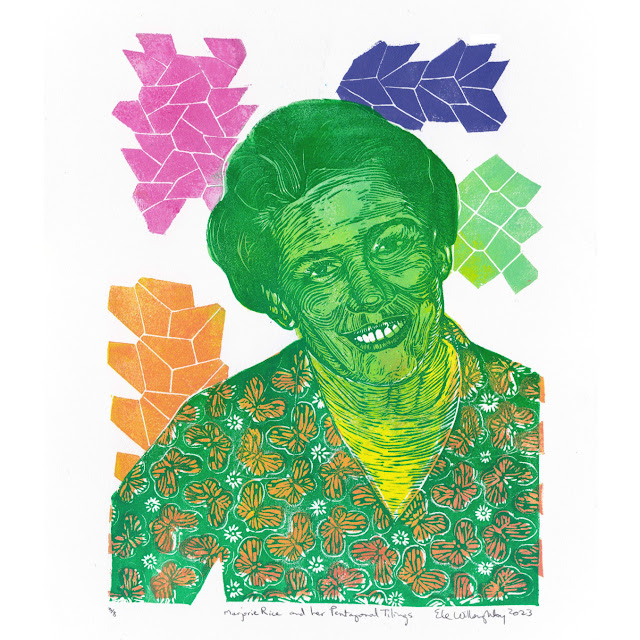 |
| Marjorie Rice and her Pentagonal Tilings, linocut, 11" x 14", by Ele Willoughby, 2023 |
This is a linocut print of Marjorie Rice (née Jeuck, 1923–2017) who discovered four new pentagonal tilings of the Euclidian plane. Each print is 11" x 14" and printed by hand. Each of her 4 new pentagonal tilings is shown and the design on her shirt is based on her own "Butterflies" tessellation using the Type 13 pentagon (with two right angles and two sides of the same length). I made this portrait for the "pattern" prompt of #printerSolstice.
Born 100 years ago, she grew up poor in Florida, attending a one-room school house, where she skipped two grades, but college was never an option for her. She married conscientious objector Gilbert Rice in 1945 and they moved to Washington, D.C., where he worked in a military hospital and she worked as a commercial artist. They moved to San Diego with their infant son, who did not survive infancy, but went on to have five more healthy children.
Rice had no training as a mathematician, having completed half of a correspondence art course after high school, but she was always interested in mathematics, puzzles and art. She began to follow Scientific American writer and amateur mathematician Martin Gardner's monthly column, rushing to devour the magazine before her son (who had the subscription) could get it. Gardner had reported in July, 1975, in his article, "On Tessellating the Plane with Convex Polygon Tiles," that mathematician Richard Brandon Kershner had finally completed the task of finding all the remaining convex polygons which could make tessellations to tile the plane, an open mathematical problem which had intrigued thinkers since Ancient Greece. But by the next month, one of his readers, Richard James III, had reported that he had found a new convex pentagon tiler. Rice was inspired to start her own search.
She spent her spare time discretely drawing diagrams on the kitchen table when no one was around which she hid when her husband, kids or friends stopped by. Her daughter assumed she was simply doodling, not discovering new mathematics. She succeeded in her search by February, 1976, and wrote Gardner of her new pentagon type and its variations in shape with which she could tile the plane. Lacking any math education, she had also developed her own notation system to describe shapes. Gardner forwarded Rice's letter to mathematician and tiling pattern expert Doris Schattschneider. Though she was skeptical of Marjorie's odd and unique notation system, which she likened to "hieroglyphics" Schattschneider was able to validate Rice's results. Rice did not stop there. By October she had found 58 pentagon tilings (most previously unknown) of two paired pentagons which could tile "transitively" which she categorized in 12 classes. By December she had found two more new convex pentagon tilers and 75 distinct tessellations by pentagons that were in blocks that could be seen as "double hexagons". By the following December (1977), she found her fourth convex pentagonal tiler and 103 "2-block transitive" pentagon tilings. Through the next decade she continued to find more pentagonal tiling patterns and explored aperiodic tilings and she used her discoveries to make Escher-like tessellation patterns of flowers, shells, butterflies and bees overlain on the geometric shapes (which can still be seen on her website).
Martin Gardner included Rice's discoveries in a collection of his columns 'The Mathematical Gardner', in 1988 and Doris Schattschneider’s article 'In Praise of Amateurs.' Though she was too shy to ever publish her own results or give any talks about her work, Schattschneider convinced Rice and her husband to attend her talk about Rice's work at a meeting of the Mathematical Association of America held in Los Angeles, in 1995. When she was pointed out in the audience, she received a standing ovation! In 1996, she was the subject of a documentary on CBC's 'The Nature of Things.'
The Mathematical Association of America in Washington, D.C. had one of the ceramic tiles of one of the tilings discovered installed in the foyer of the headquarters of 1999. Rice's papers and research notes are preserved at the Eugène Strens Recreational Mathematics Collection at the University of Calgary Library. Michaël Rao, with a computer-aided mathematical proof in 2017, established that there are a total of precisely 15 families of convex pentagons, including Rice's 4. He employed her same approach: considering how corners could come together at vertices. Rice was tickled to be recognized and loved being able to discover something new, long sought after by mathematicians
Sources
Marjorie Rice, Wikipedia, accessed February, 2023
Marjorie Rice, Intriguing Tessellations, accessed February, 2023
Natalie Wolchover, Marjorie Rice's Secret Pentagons, Quanta Magazine Abstractions Blog, July 11, 2017
Anna Weltman, Marjorie Rice, Inspired by Math, and Subways, Math Munch, February 25, 2013









1 comment:
Superb article. Thank you for posting this. I had been searching for a tessellation topic, in honour of international Women's Day. Not too many women tessellation artists out there. Maybe a dozen worldwide.
Cheers (an anagram of Escher)
Francine
www.tessellations.ca
Post a Comment